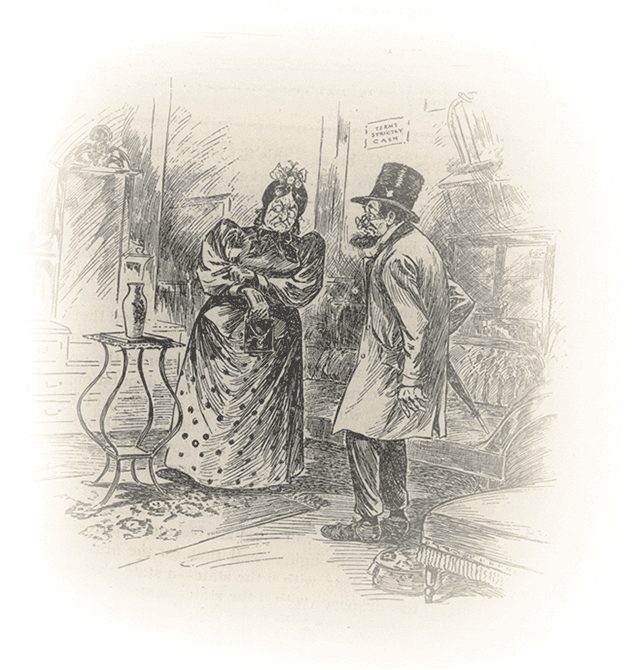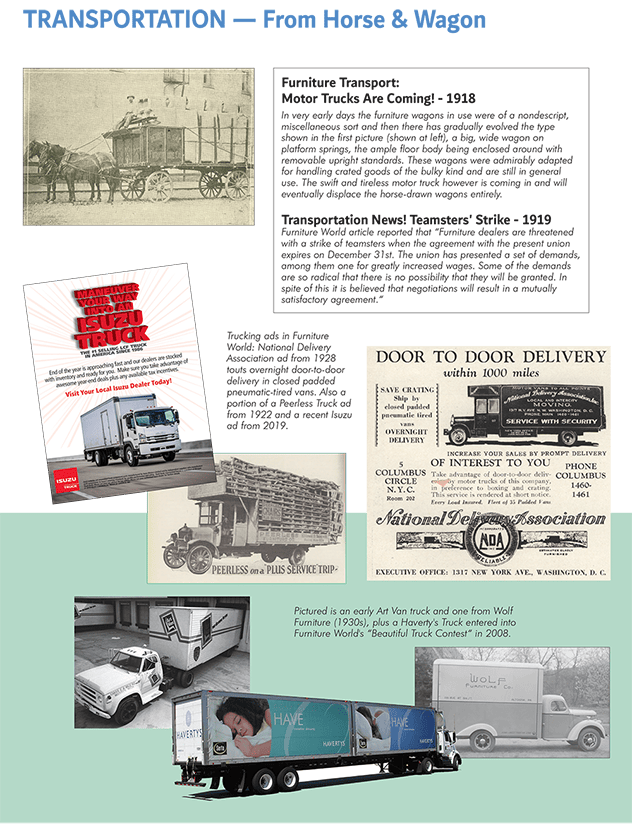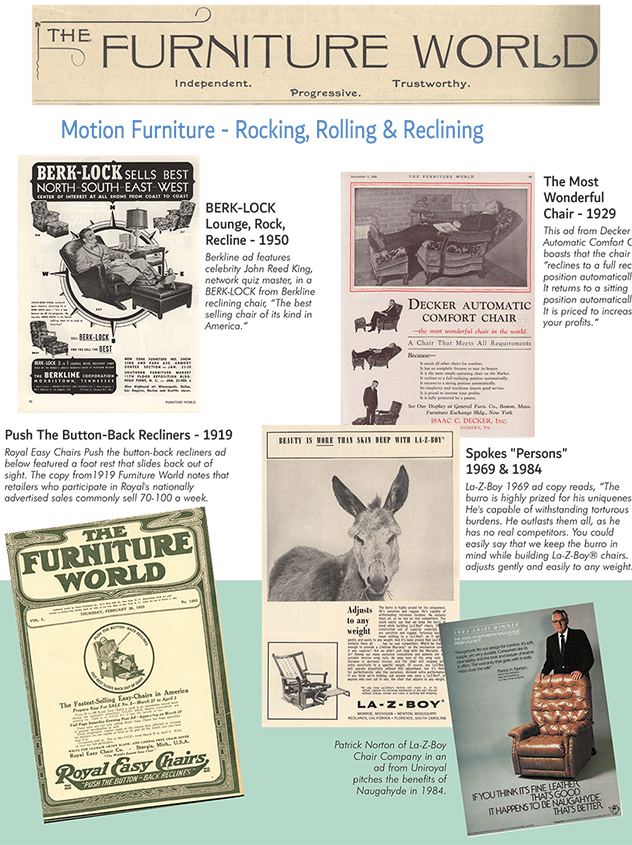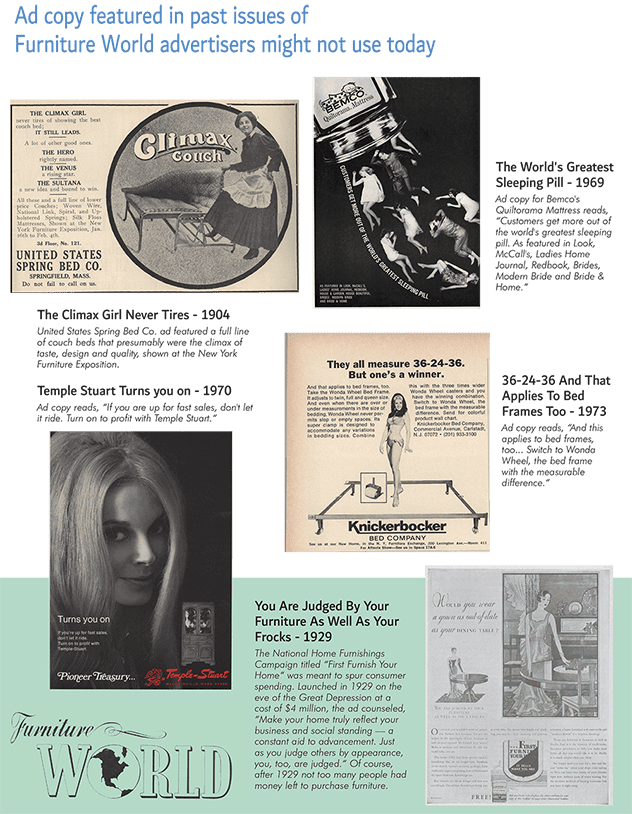
Retailers are arrested, die
of apoplexy, visit furniture shows and pioneer DTC mattress sales models. It's the same old home furnishings business!
Just 10 years following the founding of the Pony Express, the first copy of Furniture World's predecessor publication “The Cabinetmaker“ made its way into the mails. By 1870, Ulysses S. Grant had been in the White House for about a year, the US Government just recognized the new French Republic and people mourned the recent death of Charles Dickens.
1895–A Changing World
By 1895, the entire world of furniture had changed.
The furniture industry had transitioned from creating its products in cabinet-making shops to mechanized factories. This was a continuation and an acceleration of a trend started in the US three quarters of a century earlier with the founding of the Hitchcock Chair Company in 1818.
As the industry matured, manufacturing moved westward. By 1870, the states of Illinois, Michigan, Indiana and Ohio were becoming important furniture manufacturing centers.
At the same time, a new generation of retail furniture stores emerged. Dry goods stores and funeral parlors expanded their operations to include furniture. Department stores continued to be a major force in furniture sales for years to come. In 1896, Sears & Roebuck introduced it's general merchandise catalog, selling many categories of home furnishings including furniture.
Furniture World Responds to Change
John Towse started publishing New York based “The Furniture World“ in response to these changes. Furniture World would later acquire the rights to “The Cabinetmaker.“
Furniture World's staff included G. H. Langworthy who was listed as Secretary. She would become editor and owner of the publication. Mrs. Langworthy, nicknamed the “Mother Angel“ of the furniture industry, would hire N.I. (Sandy) Bienenstock in 1922 to put the publication on sound financial footing following an incident involving an embezzler and the mistress of a major New York furniture retailer.
Sandy Bienenstock eventually purchased Furniture World, established the Bienenstock Furniture Library in High Point and was inducted into the American Furniture Hall of Fame.
In 1895, Furniture World turned away from articles about furniture production and cabinet making materials in favor of reporting business opportunities, editorial commentary and information on weekly market conditions in major furniture producing and consuming centers such as Philadelphia, Grand Rapids, Chicago and Cincinnati.
If you think you've had a tough time in 2020. Read a sampling of
the misfortunes in the furniture industry as reported in 1918 and 1919 during the 'Spanish Flu' pandemic.
|
19th Century Journalism
In the April 4, 1895 edition, John Towse wrote, “The Furniture World will be a newspaper, independent in opinion, progressive in everything pertaining to nineteenth century journalism, trustworthy in its news columns. It will not only be inexpensive, but bright, and will be made a welcome weekly visitor to the factory and office of the manufacturer as well as to the store and counting room of the retailer… Its career will be unbiased and unprejudiced against men or markets, with friendship for all and malice toward none. The United States will be its field, the world its source of inspiration.”
Judging by letters received from subscribers and advertisers, Furniture World was well received. For example, E.B. Reve wrote, “Enclosed find a money order for $2, in payment for my subscription. I congratulate you on the snap and vim in the first issue. The child was born with all its hair and teeth. If it gets better as it gets older, it will be a corker.”
A Changing Industry
Boston and New York were early centers of furniture production. In Boston, before 1895, furniture manufacturers took their products by boat to nearby towns and auctioned them off on the dock. Sales were not always brisk, causing goods to often be sold at large discounts. Necessity being the mother of invention, small groups of furniture producers decided to try to get buyers to come to them.
By 1870 a movement was underway to try to bring buyers to the goods instead of bringing goods to buyers. Throughout the 1870s and 1880s, furniture manufacturers held small cooperative displays, mostly in warehouses. This solution proved less than satisfactory and expensive for buyers who had to travel long distances to view goods without the advantages of modern roads or “horseless carriages.”
Commenting on this early system, William M. Bangs would later write in a 1911 Furniture World article about a manufacturer who offered to send a carriage to pick up buyers wanting to inspect his furniture lines. Bringing in buyers one at a time Bangs observed, was like “an attempt to irrigate the Sahara desert with a watering pot.” Under such a system, he said, “the command upon the attention of buyers was uncertain and as tenuous as the tail of Halley’s comet proved to be.”
First Major Furniture Show
Charles Spratt believed he had a solution. Furniture World reported that he arranged a series of meetings sponsored by the Central Furniture Manufacturers’ Association. The result was that the American Furniture Manufacturers’ Exposition was formed on March 12, 1891. The new association took over a building on 3rd Avenue and 63rd Street in New York City, renting space at 10 cents per square foot for the purpose of “selling to the furniture trade only.” Retailing was strictly forbidden. At first, only Eastern manufacturers were permitted to show at the exposition, but these rules were soon relaxed. Mid western companies were admitted as well. Spratt, who soon became a traveling salesperson for Furniture World, believed that in order to establish a national market, there must be no limitation imposed on or advantage given to individual exhibitors based on their geographic location.
In an 1895 edition of Furniture World, Mr. Spratt declared, “It is the desire of every dealer of any business energy to go to market, but unless he has a very large business, he cannot afford either the time or money to semi-annually spend a month traveling over five states, through snow or oppressive heat, and seeing but several lines a day, whereas he can come to New York in January and July, and in a comfortable and business like manner, inspect in one building, within a few days’ time, samples from over one hundred and fifty factories, meet manufacturers with whom he is in constant business correspondence, adjust pleasantly any little misunderstandings that may have arisen, and after buying what he needs, go home with the intense satisfaction of having seen the goods he bought, and acquired a thorough knowledge of the conditions of the markets and the seasons’ offering before he placed an order.”
Shows Spread West
Furniture shows in other areas of the country were being built to support furniture manufacturing across regional areas, including those in New York, Chicago, Rochester, Cincinnati, Boston, Philadelphia, Indianapolis, Rockford, St. Louis, Grand Rapids, Jamestown and Shelbyville.
The Grand Rapids market was similar to New York in size and the Jamestown Market was not far behind. By the printing of the July 4, 1895 issue, Furniture World reported that Jamestown had just about joined the ranks of the three major markets of New York, Chicago and Grand Rapids. “Jamestown is ambitious,” the article noted, “and if this year’s experiment is a success, she will be on the list. She has done notable preparatory work, and her visitors will enjoy the delightful surroundings of Celeron Hall.”
At the summer 1895 furniture exhibition, New York City boasted nearly 200 exhibitors housed in 121,000 square feet of exhibition space, attracting over 1,500 buyers.
It's interesting that as soon as furniture shows appeared on the scene, there was talk of having a single national show. The July 11, 1895 issue featured a cartoon titled, “The Enthusiasts Dream of A National Furniture Exposition.“ This was an idea repeated throughout the years in many letters to the editor and opinion pieces in Furniture World. Depicted in the drawing was a large building with flags representing the furniture exhibitions of the time. Grand Rapids, once the premier furniture show ceded dominance to Chicago, and then to High Point. Las Vegas, Dallas, Atlanta, San Francisco and many other smaller regional shows entered the mix.
Much about the way the furniture industry buys, markets and sells home furnishings was in place by the time Furniture World completed its first year of publishing under it's new name. Since then, Furniture World has been published continuously through Word War I and the so called Spanish Flu pandemic (historians say it may have started in Kansas), the Great Depression, the cold war, social upheaval and many boom and bust cycles.
Regarding Furniture World's coverage of the pandemic that killed millions world-wide from early 1918 through spring 1920— there wasn't any! Whereas in 2020, a huge amount of press coverage has been devoted to the COVID-19 pandemic, coverage 100 years ago was suppressed by the government in an attempt to maintain high soldier and citizen morale throughout the war. The Sedition act of 1918 passed under president Woodrow Wilson forbade citizens to utter, print, write, or publish any information that might impede recruiting or damage the war effort with a maximum fine of $10,000.
Pandemic Problems 1919
If you think retailers and manufacturers have had a tough time in 2020, read a sampling of the misfortunes in the furniture industry as reported in 1918 and 1919 during the Spanish Flu pandemic estimated to have killed as many as 625,000 people in the U.S.
Furniture Dealer Loses Finger Hunting Rabbits:
G.H. Patrick, furniture dealer at Lyons, IL, near Chicago had the index finger of his right hand blown off last week while out hunting rabbits. He was standing with he butt of the gun on the ground and his right hand over the muzzle when the weapon was in some manner discharged.
 Cartoon from an 1895 Furniture World issue.
“We don't buy nothing here, Silas! Look how the weight of that little vase bent the legs on that brass table.“
Cartoon from an 1895 Furniture World issue.
“We don't buy nothing here, Silas! Look how the weight of that little vase bent the legs on that brass table.“
|
Furniture Clerk Found Dead:
Charles Overman, a clerk in a north side furniture store, was found dead in a gas-filled room by his landlady last week. He had complained of the difficulty of making ends meet on his salary, according to witnesses at the coroner's inquest. He was twenty-eight years of age.
Retailer Killed. Creditor's OK:
Emil Sachs, 1807 Milwaukee Avenue, shot and killed himself in his store last week. His action is traced to domestic trouble. He had been in business for the past six months at the present address. Prior to that time he had been in the Navy. Creditors regard the business as solvent, and believe that all claims will be satisfied after a sale.
Wood Finishers Indicted:
Orders to cease and desist from the practice of commercial bribery have been issued against the New York Wood Finishers' Supply Co., by the Federal Trade Commission.
Retailer's Payroll Stolen:
The safe in the office of the Gold Furniture Co., was blown last week, and $15,000 in cash and liberty bonds were stolen. The loot included the company's weekly payroll, which had been locked in the company's vaults over night for distribution on the following day.
Retailer Defrauds Creditors:
Wilber Coufel, a furniture dealer, of Gary, Ind., has been arrested on a charge that he sought to defraud his creditors. Coufel is now out on bail.
Arrested With Their Wives:
Samuel Salef and Harry Liberman, owners of Star Upholstered Furniture were arrested together with their wives, Leah Salef and Dora Lieberman, charged with conspiring illegally to obtain merchandise, also with assault.
Furniture Industry Graft:
A Michigan furniture manufacturer writes us as follows: “We want to express to you our appreciation of the article in your paper of February 12th regarding the furniture graft of the Michigan Retail Furniture Dealers' Association. If there is one particular thing among the many that Furniture World has done in elevating conditions in the furniture business, exposing of this kind of graft is very commendable.“
Cohen Furniture Brothers Arrested For Egg Larceny:
Dave Cohen, brother of Harry J. Cohen who planned and executed a fraudulent (furniture store) failure, was arrested in this city (Gettysburg, PA) last week accused of the larceny of a consignment of eggs valued at $570 and belonging to Albert Hollinger of Adams County, PA. He was also charged with false pretense concerning the disposal of the eggs. Jacob Cohen, another brother, who was also connected with the Cohen failure, was arrested at the same time on the same charge. Both Dave and Jacob Cohen were held under $800 bail each, in the City Hall Police court for a hearing.
Trooper Shoots Furniture Man:
Louis Berger, the furniture dealer, who operates a retail store at 5243 Market Street, was proceeding along the boulevard in his own truck, which was being driven by a chauffeur. It seems that the truck was being driven at a fast rate of speed and after very nearly upsetting a passenger automobile was pursued by the State trooper. The driver of the truck refused to stop and the constable drew his revolver and jumped on the step of the truck. The chauffeur threatened the trooper with a hatchet and Berger kicked at the hand holding the gun. The trooper was thrown from the truck and the gun discharged, the bullet striking the furniture dealer in the arm. The verdict returned by the jury stated that death was due to apoplexy caused by the fright from the wound.




Russell Bienenstock is Editor-in-Chief of Furniture World Magazine, founded 1870. Comments can be directed to him at editor@furninfo.com.